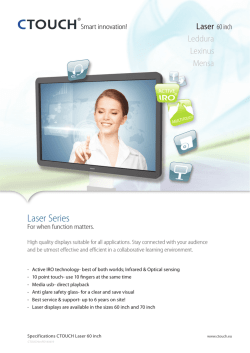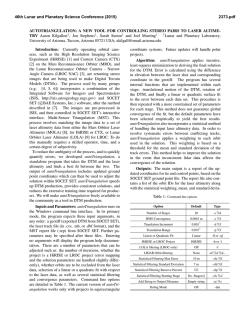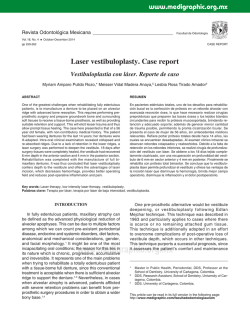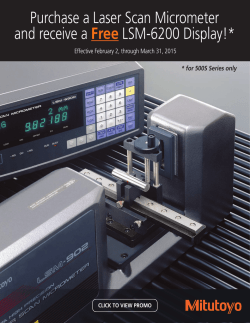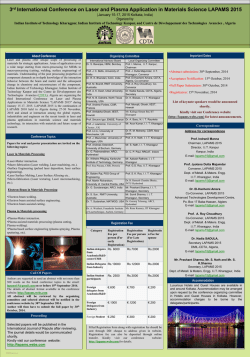
Masters (MSc) Degree in Laser Dentistry at the University of Genoa
Masters (MSc) Degree in Laser Dentistry at the University of Genoa (Genoa, February 2015 - November 2016) The use of lasers in dentistry has now become a part of everyday clinical practice. Rapid development of technology has led to instruments with ever-improving performance; teamed with traditional methods, such laser-based instruments offer value-added benefits to primary dental treatment. Any advanced technological aids, i.e. operating microscope, piezoelectric devices, and laser require adequate know-how with a progressive learning curve. In 1999 at the University of Genoa, Prof. Alberico Benedicenti, pioneer researcher in this field established the first Proficiency Course in Italy in the use of laser photonic energy in adjunctive use in treatment of appropriate head and neck conditions. Responding to the needs of clinicians for adequate theoretical and clinical instruction, the course was set up following the foundation of the first university “Laser Therapy Center” department, within the Faculty of Medicine. Having reached its 12th year, the proficiency course expanded in 2011 to an International Masters in Laser Dentistry (MSc) degree course. The next MSc degree course will commence in February 2015. The Masters Programme is a 2-year course. In the first year, students will follow a course equivalent to the Proficiency Certification. Those who decide to complete the second year will prepare and present a thesis on one of the topics dealt with in the course, after which they will be eligible to receive the Masters degree. In addition to offering personal post-graduate Professional enrichment, the new University Masters Programme will enable the student, under the supervision of a tutor to learn directly and also practice laser techniques which are Internationally accepted as “state-of-the-art”. Educational objectives λ To provide postgraduate students with the confidence and ability to enhance their current clinical practice by incorporating the latest advances in technology and research in the use of lasers in dentistry. λ To provide an innovative programme which enhances current knowledge and clinical skills in laser use in dentistry λ To present sound academic theory and high quality practical training by world class mentors λ To deliver learning using the latest technology enabling students to access the course, whilst maintaining their commitment to their clinical practice. Through lessons on theory and hands-on participation activities the Masters course aims to help the student acquire specific proficiency and clinical experience in laser wavelengths principally used in dentistry. The clinical experience activities will be held in the new department of laser therapy and surgery, with procedures performed by participants under the guidance and supervision of teachers. The course is International in character with affiliations with European and American universities. The courses will be conducted in English. Classroom and distance learning In addition to a traditional classroom learning situation, there will be audio/video recordings of the lessons available for online access. The hands-on learning activities will be held within the Department. Admission Criteria λ Applicants must be able to satisfy the general admissions criteria of the university. λ Applicants must provide evidence of their primary dental qualification from a recognised institution. λ Applicants will have completed a preliminary course of instruction in the use of lasers in dentistry. λ Applicants will own or have access to and routinely use a laser for application in clinical dentistry. λ Applicants will make payment as required of course fees as applied by the University of Genoa. Faculty Principals: Professor Professor Professor Professor Professor Professor Professor Professor Stefano Benedicenti (Director). Alberico Benedicenti a.c. Rolando Crippa a.c. Giuseppe Iaria a.c. Giovanni Olivi a.c. Steven Parker a.c. Ercole Romagnoli a.c. Wayne Selting Additional teaching faculty to be drawn from Internationally-accredited experts in the field of laser use in dentistry and medicine. Location: University of Genoa – DI.S.C. - Department of Surgical and Diagnostic Sciences, San Martino Hospital pavilion 4, Largo R. Benzi 10, Genoa, Italy Cost: The cost of each academic year is 4,500 Euros. Total 9,000 Euros. CME Credits: CME credits are accrued during the course and are equivalent to National verifiable hours of continuing education. Information: E-mail: [email protected] E-mail: [email protected] Maximum number of participants: 30 Students Registration deadline: December 2014 Course program and dates Proposals for 2015 – 2016 λ The MSc course will be conducted with English as the spoken language. λ The course shall continue as a mixture of on-campus lectures and practical sessions (San Martino Hospital, Pavillion 4, Genoa, Italy) and personal student study conducted at home and on-line. λ The on-campus meetings shall be conducted as three individual weeks, each week running from Monday afternoon (start 14.00) to Saturday lunchtime (13.00) inclusive. λ Students shall be liable for hotel and flight expenses. The number of meetings will impact favourably on the cost of airfares. Hotel accommodation shall be at AC Hotel, Corso Europa, Genova. 2015 Dates for in-campus attendance. Each day shall run from 09.00 -17.00. Detailed programmes for each period of lectures and practical session shall be made public in advance. λ February 2015 Monday 23rd – Saturday 28th λ June 2015 Monday 15th – Saturday 20th λ October 2015 Monday 19th – Saturday 24th Dates 2016 To be announced MSc in Laser Dentistry Università degli Studi di Genova February 23rd – 28th 2015 Overview of subject coverage: Photonics / Basic laser physics and operating parameters / Introduction to MSc course Monday 23rd February 2014 Principal Faculty: S. Benedicenti, S. Parker, W. Selting, E. Romagnoli, A. Matthews Additional Faculty: E. Anagnostaki, H. El Hallal, R. Hanna, R. El Faghali, M. Cronshaw, R. Poli 14.30 S. Benedicenti Welcome 14.40 Teaching Faculty Overview of MSc Course Introduction to faculty. Aims and objectives of MSc course Declaration of value explained 16.00 Coffee 16.30 Teaching Faculty Overview of MSC Course (cont’d) W. Selting Preparation for Literature Review 18.00 Close ____________________________ // _____________________________ Tuesday 24th February 2015 Faculty: S. Benedicenti, S. Parker, W. Selting, E. Romagnoli, Additional faculty 09.00 Dr S. Parker Photonic energy. History of photonics 10.00 Dr Ercole Romagnoli Relationship of laser emission to “ordinary” light. 11.00 Coffee 11.30 Dr Wayne Selting 12.45 Lunch Production of laser photonic energy by solid-state, gas and semi-conductor- based laser machines. Emission modes. Basic laser parameters. 14.00 Student group 15.15 Coffee 15.45 Student group Cont’d. 16.00 S. Parker / Additional faculty 18.00 Presentation of clinical cases – 1 case (2-3 slides) per student. Presented as forum discussion. Presentation of clinical cases – 1 case (2-3 slides) per student. Clinical case exam overview and 2013 graduate case presentation. Close ____________________________ // _____________________________ Wednesday 25th February 2015 Faculty: S. Benedicenti, S. Parker, W. Selting. E. Romagnoli Additional faculty 09.00 Dr S. Parker W. Selting Introduction / overview of practical exercises 09.30 Teaching Faculty Student exercise to compile basic categorisation / delivery mechanisms and operating parameters of lasers in Department. 11.30 Coffee 12.00 Company presentation of lasers to demonstrate wavelength capabilities 13.00 Lunch 14.00 Dr W. Selting Laser photonic energy delivery. Fibre initiation. 14.30 Teaching Faculty Student exercise to use 3 wavelengths (Diode / Nd:YAG, Er,Cr:YSGG / Er:YAG, CO2 ) to ablate soft tissue. To use Erbium laser to ablate hard tissue. Each ablation to be photographed by member of Faculty. Detailed programme to be provided 15.45 Coffee 16.15 Teaching Faculty 18.00 Close Student exercise (Cont’d) ____________________________ // _____________________________ Dr Thursday 26th February 2015 Faculty: S. Parker, W. Selting, A. Benedicenti, E. Romagnoli, Additional Faculty 09.00 Teaching faculty 10.30 Coffee 11.00 S. Parker 13.00 Lunch 14.00 Teaching Faculty Presentation of student photographs from Wednesday. General discussion. Laser – tissue interaction. Student exercise to perform gingivectomy and crown lengthening (open flap / closed flap). Laser companies to assist with machines 18.00 Close ____________________________ // _____________________________ Friday 27th February 2015 Faculty: S. Benedicenti, S. Parker, W. Selting, E. Romagnoli. Additional faculty 09.00 W. Selting 10.30 Coffee 11.00 S. Parker 13.00 Lunch 14.00 Teaching faculty 15.30 Coffee 16.00 Faculty TBA Aspects of applied laser – tissue interaction in soft tissue Laser management of the gingival margin Overview of thesis requirements. Resource of reference material. Mentor responsibilities explained. Presentation of examples of theses from 2013/14 MSc Mentor assignment for 2015 / 16. Requirement for June meeting. 18.00 Close ____________________________ // _____________________________ Saturday 28th February 2015 Faculty: S. Parker, W. Selting, A. Benedicenti, E. Romagnoli, Additional Faculty 09.00 Dr A. Matthews Laser photobleaching. Introduction Dr E. Anagnostaki 09.30 Dr. Jihad Habli 10.30 Coffee 11.00 Dr A. Matthews Clinical cases of bleaching Laser photobleaching (Cont’d) Dr E. Anagnostaki 12.30 13.00 Assignment for next session. Literature review exercises. On-line MCQ exam Close ____________________________ // _____________________________ Syllabus Overview The two-year Master of Science (MSc) in Laser Dentistry is a composite structure to allow maximum flexibility for the student and integration into existing General Dental Practice. Three essential areas of activity are recognised for qualification: λ Home study: Background study, preparation and literature review. λ On-campus: Commitment to receive didactic learning, hands-on learning and practice, clinical techniques teaching and evaluation, together with opportunity for consolidation of learning with faculty and mentors. At approximately 3 weeks following the on-campus meetings in February, June and October 2015, together with February 2016, there will be an on-line MCQ exam (each exam of 50 questions – 200 in total). λ Individual projects: Clinical case preparation and presentation. Dissertation and thesis preparation and presentation, together with personal research project. Areas of teaching and learning for MSc programmes. Syllabus Overview Syllabus - areas of study λ The syllabus will be underpinned by a thorough knowledge and understanding of laser physics and laser – tissue interaction. λ Additional core areas shall explore the phenomena of ablative and non-ablative uses and application of laser photonic energy. λ With such basics, the wider applications of laser use in dentistry shall be considered. λ At all times, the application of laser photonic energy shall be based on evidence and published research and considerable emphasis shall be placed on review of selected literature. λ Students shall be expected to demonstrate clinical skills commensurate with the appropriate level of post-graduate study. Clinical case presentations shall form a core example of these skills. λ The award of the MSc degree shall be based on the following: (i) Attendance at each of the in-campus sessions throughout the period of the course. (ii) Compilation and presentation of five clinical case studies of the student’s choice, to display understanding and suitable use of laser photonic energy within a clinical setting. (iii) Successful completion of a multiple-choice written examination. (iv) Presentation of a personal thesis to reflect the student’s understanding and research into a subject allied to laser use in dentistry. The areas of activity are covered during year one to a level of detail and application consistent with a postgraduate diploma. These areas are covered in greater detail and reference during year two of the MSc course, together with additional areas such as research project and thesis. Syllabus Overview Methods of Study λ Part-time distance learning: The majority of the learning resources will be online. The programme will combine interactive distance learning, webinars, live learning and print to create an integrated learning programme, using the best of new media and technology. Addition requirements will be met through the presentation of on-campus course elements provided at the University of Genoa. λ Ownership: The programme is designed to encourage the student to take responsibility for his/her own learning. The emphasis of the MSc degree is on a self-directed approach to learning. λ Resources: λ Methods of Assessment: Multiple choice questions administered after live/distance and interactive lectures and course elements are designed to appraise a level of learning consistent with expected outcomes. Documentation and pictures submitted for assessment for case studies shall be judged against the formatted assessment guidelines. Students will have access to The University of Genoa’s online library. Syllabus – core and applied areas of laser use in dentistry Syllabus Overview Foundations of Lasers in Medicine and Dentistry Aim: This unit will provide a basis of theoretical knowledge of photonics, the electromagnetic spectrum and relationship between photon energy, wavelength and frequency. The development of theory into the production of machines capable of producing coherent laser photonic energy, together with examples of current laser use in dentistry. Low level laser use Aim: This unit provides knowledge of sub-ablative (non-surgical) laser photonic energy and its interaction with target tissue elements. The concept of photobiomodulation is explored and clinical use of low-level laser devices is demonstrated. Additionally, the use of nonablative laser radiation in diagnostics is described, together with laser use in photodynamic therapy. Laser use in endodontics Aim: An overview of the pathogenesis of dentine hypersensitivity, pulpal pathology and peri-apical infection associated with the consequences of pulp death. The use of lasers in pulp flowmetry. The use of laser photonic energy in the physical preparation of the root canal, elimination of bacterial contamination and obturation techniques in endodontics. Emphasis to be given to the adjunctive use of laser radiation within accepted therapeutic protocols. The use of lasers in the treatment of apical pathology and open-flap periapical surgery. Laser safety Aim: This unit provides a comprehensive review of regulatory and practical aspects of laser safety, reflecting both IEC and ANSI(USA) regulations. Laser use with soft tissue Aim: A comprehensive exploration of all laser wavelengths with target oral soft tissue elements. Emphasis to be placed on the benefits and drawbacks of laser use verses other surgical treatment modalities. Examples of clinical techniques, comparisons of wavelengths and expected outcomes of surgical procedures on para-dontal (fixed – ketartinised) soft tissue structures and nondental, non-keratinised soft tissue structures in the oral cavity. Laser use with hard tissue Aim: A comprehensive exploration of all laser wavelengths with target dental hard tissue and alveolar bone elements. Emphasis to be placed on the benefits and drawbacks of laser use verses other surgical treatment modalities. Examples throughout of clinical techniques, comparisons of wavelengths and expected outcomes of surgical procedures. Exploration of integration of current restorative materials technology with adjunctive laser use in cavity preparation and restoration. Laser tissue interaction Aim: This unit covers all aspects of interaction between a chosen laser wavelength and a target tissue element. The influence of emission modes and power density factors, together with parameters governing thermal change within the tissue will be demonstrated. Benefits and complications of laser-tissue interaction. Laser use in periodontology Aim: Overview of pathogenesis of periodontal disease. The use of surgical and non-surgical lasers in the treatment of periodontal pathologies. Emphasis to be placed on the adjunctive role of lasers within accepted treatment modalities. Laser use in implantology Aim: An overview to be provided on the development and practical protocols associated with the placement of root-form osseointegrated dental implants. Consideration given as to the adjunctive use of lasers in the preparation of the osteotomy site and exposure of 2nd-stage implant recovery techniques. Pathogenesis of periimplantitis and the possible use of surgical and low-level laser radiation in treatment modalities. Additional adjunctive use of photosensitisers in low-level photodynamic anti-bacterial chemotherapy in the treatment of peri-implantitis. Statistics Aim: This unit will aim to provide the student with a basic appreciation of statistical analysis and how it can be integrated into research techniques. An overview will be provided of current statistical methods and how theyOverview can be applied with mathematical Syllabus examples. Students will be encouraged to complete example computations of analysis. Syllabus – core and applied areas of laser use in dentistry Unit 1. Foundations of Lasers in Medicine and Dentistry Aim: This unit will provide a basis of theoretical knowledge of photonics, the electromagnetic spectrum and relationship between photon energy, wavelength and frequency. The development of theory into the production of machines capable of producing coherent laser photonic energy, together with examples of current laser use in dentistry will be demonstrated. λ Light propagation and interaction in nature. Electromagnetic spectrum. λ Light physics. Consideration of electromagnetic spectrum. Historical perspectives. λ Physics foundations of laser photonics. Laser photonic energy propagation λ History of laser development. Photo-electric effect, MASER, LASER. Integration of lasers into medicine and dentistry. λ Basic principles of laser light production. Population inversion phenomena. λ Examples of laser units. Unit 2. Laser tissue interaction Aim: This unit covers all aspects of interaction between a chosen laser wavelength and a target tissue element. The influence of emission modes and power density factors, together with parameters governing thermal change within the tissue will be demonstrated. Additional clinical examples will demonstrate the benefits and complications of laser-tissue interaction. λ Theoretical aspects of light interaction with target tissue elements. Absorption phenomena. Calculation of absorption coefficient, ablation threshold. λ Photoablation phenomena – photovaporolysis, photoplasmolysis. λ Laser emission modes. Laser ablation of soft tissue. Laser ablation of hard tissue. Theoretical concepts. λ Factors affecting laser-tissue interaction. Power density phenomena. Contact / non-contact applications. Physical parameters of laser applications- beam angle, adjunctive cooling factors. Tissue thermal relaxation concepts and applications. λ Benefits of laser tissue interaction. Complications – wavelength, power, anatomy. λ Literature Review A selective literature review of theoretical and clinical articles will be studied and assessed. Unit 3. Laser safety Aim: This unit provides a comprehensive review of regulatory and practical aspects of laser safety, reflecting both IEC and ANSI(USA) regulations. λ Factors contributing to the need for laser safety λ Regulatory framework defining laser safety. IEC, ANSI Regulations. λ Review of computation of MPE, NOHD for differing laser wavelengths λ Factors that affect safety within the controlled area λ Defining a “best practice” approach to laser safety. Local Rules λ Literature Review. A selective literature review of theoretical and clinical articles will be studied and assessed. Unit 4. Low level laser use Aim: This unit provides knowledge of sub-ablative (non-surgical) laser photonic energy and its interaction with target tissue elements. The concept of photobiomodulation is explored and clinical use of low-level laser devices is demonstrated. Additionally, the use of non-ablative laser radiation in diagnostics is described, together with laser use in photodynamic therapy. λ History of low level photonic energy use. Heliotherapy. Photobiomodulation λ Overview of differing uses of low-level photonic energy λ Intra-cellular aspects of low-level laser radiation λ Extra-cellular aspects of low-level laser radiation. Pain control, Aspects of inflammatory response modulation. λ Photo-dynamic therapy. Development, applications, theory. λ Clinical aspects of PDT. Anti-bacterial aspects. Clinical techniques. λ Photodiagnosis. Theory. Applications. Caries detection. OCT techniques. λ Literature Review. A selective literature review of theoretical and clinical articles will be studied and assessed. Unit 5. Laser use with soft tissue Aim: A comprehensive exploration of all laser wavelengths with target oral soft tissue elements. Emphasis to be placed on the benefits and drawbacks of laser use verses other surgical treatment modalities. Examples throughout of clinical techniques, comparisons of wavelengths and expected outcomes of surgical procedures on para-dontal (fixed – ketartinised) soft tissue structures and non-dental, non-keratinised soft tissue structures in the oral cavity. λ Overview of absorption phenomena relative to wavelength λ Anatomical considerations λ Laser use with non-keratinised, non-attached oral soft tissue λ Laser use with keratinised, attached soft tissue. λ Clinical techniques. Comparison of wavelengths and surgical procedure. λ Literature Review. A selective literature review of theoretical and clinical articles will be studied and assessed. Unit 6. Laser use in periodontology Aim: Overview of pathogenesis of periodontal disease. The use of surgical and non-surgical lasers in the treatment of periodontal pathologies. Emphasis to be placed on the adjunctive role of lasers within accepted treatment modalities. λ Consideration of pathogenesis of periodontal disease. Overview of current theory. λ Role of laser radiation in treatment of prime aspects of periodontal disease. λ Laser use in gingival curettage. Techniques, benefits, drawbacks, comparisons with conventional techniques. λ Laser use in bacterial decontamination. Techniques, benefits, drawbacks. Comparison with conventional treatment modalities. λ Laser use in calculus removal. Techniques, benefits, drawbacks. Comparison with conventional techniques. λ Laser use in reconstructive surgery. Infra-bony pocket treatment. GBR techniques. λ Use of Low-level lasers in periodontal treatment. PACT techniques. λ Literature review. A selective literature review of theoretical and clinical articles will be studied and assessed. Unit 7. Laser use with hard tissue Aim: A comprehensive exploration of all laser wavelengths with target dental hard tissue and alveolar bone elements. Emphasis to be placed on the benefits and drawbacks of laser use verses other surgical treatment modalities. Examples throughout of clinical techniques, comparisons of wavelengths and expected outcomes of surgical procedures. Exploration of integration of current restorative materials technology with adjunctive laser use in cavity preparation and restoration. λ Overview of absorption phenomena relative to wavelength λ Consideration of thermal phenomena relative to pulse delivery and hard tissue ablation. λ Anatomical considerations. Cavity design considerations. Micro-retention composite technology relative to cavity preparation using laser photonic energy. λ Laser tissue interaction with enamel. Prime chromophore interaction. Spallation. λ Laser tissue interaction with dentine. Prime chromophore interaction. Removal of λ Laser effects on hard tissues: SEM investigation, analysis and comparison with traditional techniques λ Adhesion to laser-treated tissues. Micro leakage and bond strength. Clinical procedures λ Temperature rise in pulp chamber during cavity preparation. Deep dentin treatment and decontamination λ Use of laser radiation in bone surgery. Anatomical / surgical considerations. λ Literature Review A selective literature review of theoretical and clinical articles will be studied and assessed. Unit 8. caries. Laser use in endodontics Aim: An overview of the pathogenesis of dentine hypersensitivity, pulpal pathology and periapical infection associated with the consequences of pulp death. The use of lasers in pulp flowmetry. The use of laser photonic energy in the physical preparation of the root canal, elimination of bacterial contamination and obturation techniques in endodontics. Empasis to be given to the adjunctive use of laser radiation within accepted therapeutic protocols. The use of lasers in the treatment of apical pathology and open-flap peri-apical surgery. λ Consideration of pathogenesis of pulpal inflammation / infection. Overview of current theory of endodontic treatment of deciduous and permanent teeth. λ Overview of absorption phenomena relative to wavelength λ Consideration of procedures. Laser pulpal flowmetry. Pulp capping, laser-assisted canal preparation, laser-assisted bacterial reduction. λ Additional clinical applications. Laser-assisted canal obturation. Laser-assisted apical surgery. Dentine hypersensitivity. λ Literature Review A selective literature review of theoretical and clinical articles will be studied and assessed. Unit 9. Laser use in implantology Aim: An overview to be provided on the development and practical protocols associated with the placement of root-form osseointegrated dental implants. Consideration given as to the adjunctive use of lasers in the preparation of the osteotomy site and exposure of 2nd-stage implant recovery techniques. Pathogenesis of peri-implantitis and the possible use of surgical and low-level laser radiation in treatment modalities. Additional adjunctive use of photosensitisers in low-level photodynamic anti-bacterial chemotherapy in the treatment of peri-implantitis. λ Overview of current theory and application of osseointegration in relation to implantology. λ Risk analysis of laser radiation in implantology. Review of wavelength / temporal emission modes and effects on implant surface. λ Laser-assisted procedures in relation to implantology. Osteotomy preparation, 2nd – Stage recovery of implants. λ Pathogenesis of peri-implantology. Consideration of current treatment protocols. Use of laser radiation in the adjunctive treatment of peri-implantology. λ Literature Review A selective literature review of theoretical and clinical articles will be studied and assessed. Unit 10. Statistics Aim: This unit will aim to provide the student with a basic appreciation of statistical analysis and how it can be integrated into research techniques. An overview will be provided of current statistical methods and how they can be applied with mathematical examples. Students will be encouraged to complete example computations of analysis. λ Overview of statistics. Terminology. Mathematic application. λ Concepts in research design, data collection, analysis and interpretation with particular relevance to laser use in dentistry. λ Literature review of published papers covering research methods will be studied. Unit 11. Esthetics in dentistry and medicine Aim: This topic will cover laser procedures in esthetic dentistry and medicine ***NOTE: Some aspects of this module may not be compatible with National / State licensing Boards and may be omitted for the individual student who may be affected by such rulings ***. Modern concept of face beauty λ Overview of current application of pulsed light ( IPL) and laser light for hair removal, skin rejuvenation-biostimulation, smoothening of wrinkles, skin resurfacing, acne and scar reducing, improving texture and laxity. λ Modern concepts of smile design and esthetic dentistry λ Tooth Bleaching λ Impression/gingival sulcular preparation λ Gingival re-contouring λ Osseous crown lengthening λ CAD-CAM impression and ceramic restoration Unit 12. Case Studies Aim: The outreach of the degree is determined as a qualified level of competence in both theoretical and practical aspects of laser dentistry. The submission of clinical cases shall be deemed as evidence of adjunctive laser use in the delivery of primary dental care. The postgraduate diploma level shall be the submission of 5 (five) case studies in a chosen laser wavelength or combined laser wavelengths. A formatted template shall enable a standardised approach to clinical case submission. Additional to this unit shall be a guide to photographic techniques and MS PowerPoint techniques (Mac equivalent). Submission of clinical cases shall be in hard copy and digitised formats. λ Detailed guidelines for case presentation and photography will be provided. λ Photographic documentation and written descriptions of clinical cases will be submitted online, using a pre-formatted template file for assessment purposes. λ Minimum requirements - images will include before, after and significant steps during the treatment to portray the use of the chosen laser wavelength and technique. ** See Appendix # 1 Clinical Case Presentation Template Unit 13. Dissertation Aim: The dissertation is the final element of the MSc course. Each student shall be required to submit a 15,000 word thesis. A member of the faculty shall be assigned to the candidate, depending on the chosen area of laser use in dentistry. This mentor shall be responsible for guiding the student through thesis development, writing and presentation process (as per university current guidelines). ** See Appendix # 2 Dissertation assessment sheet. Multiple-choice written examination. A 200 question MCQ paper will be given for each student to complete. Time allowed: 3 Hours. Pass mark: 70% Outline of on-campus meetings by date and subject area covered Month Laser Basics Laser-tissue Interaction Laser Safety Low Level Laser Laser Soft Tissue Perio Laser Hard Tissue Laser Endodontics Laser Implants Statistics Research Case Studies Hands-on Dissertation Month Laser Basics Laser-tissue Interaction Laser Safety Low Level Laser Laser Soft Tissue Perio Laser Hard Tissue Laser Endodontics Laser Implants Statistics Research Case Studies February 2015 X X Year One 2015 June 2015 X X X X X X X X X October 2015 X X X X X X X X X X X X Year Two 2016 February 2016 June 2016 X X X X X X X X X X X X X X X X October 2016 Student presentation of completed clinical case studies – one as a Powerpoint / MAC presentation viva and 5 cases as digitised copy format. Student presentation of completed Thesis – 15,000 words in hard copy and digitised copy formats. Students sit MCQ written examination – 200 questions, 3 hours. Pass mark 70%.
© Copyright 2025
